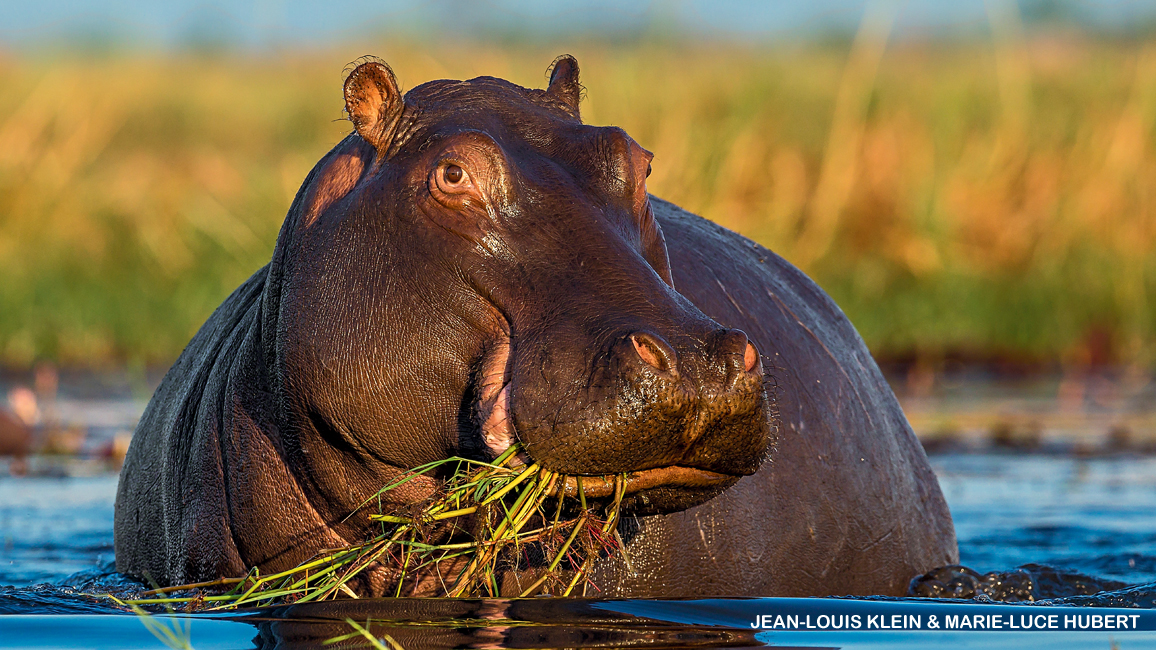
Hippos
By Anne CisselThis enormous mammal loves to hang around in water and snack on grassy treats. But don’t get on its bad side!

Well, hello there, hippopotamus! This hungry giant looks as if it’s grinning at us. But, unless you were at a zoo, you wouldn’t want to get this close to a hippo in real life. A hippo spends most of its life peacefully resting in lakes and slow-moving rivers of Africa south of the Sahara Desert. It’s not a hunter—it eats only plants. Even so, many people think it is the most dangerous animal in Africa.
First of all, it’s huge! It is the third-heaviest land animal on Earth. (Elephants weigh the most, then some rhinos.) A hippo weighs about as much as a medium-sized car. Even its skin is super-sized. Your skin is about as thick as a nickel. A hippo’s skin is as thick as two stacked hockey pucks! You might think such a hefty animal would be slow. In fact, a hippo can run much faster than you can—even though it has short legs. And if it feels threatened, it often attacks. Yes—it’s best to stay far away from a hippo’s long, razor-sharp front teeth and powerful jaws. But it’s an amazing animal, so let’s take a peek . . . from a distance!

HIPPO LIFE
Hippos are built for life in the water. In fact, their closest living relatives are whales, porpoises, and dolphins. Hippos’ eyes, ears, and nostrils are on the tops of their heads. That allows them to see, hear, breathe, and smell when they are almost completely underwater. When diving, hippos flatten their ears against their heads and close their nostrils tightly. Their eyes have lids like yours that open and close. But hippos also have see-through inner lids that act as goggles to protect their open eyes underwater. And they can stay under without taking a breath for more than five minutes.
But hippos prefer shallow bodies of water. They aren’t built for floating and aren’t very strong swimmers. Beneath the surface, they often walk on the bottoms of lakes or rivers. Most of the day, they smush together in big groups in water or mud, keeping cool under the hot African sun.
When the sun sets, hungry hippos waddle out of the water to eat grass, leaves, bark, and fruit on land. They eat at night because the sun can dry or burn their skin. But, if they are out of the water during the day, their skin oozes a pink, sticky fluid that is a built-in sunscreen.
A female hippo usually has only one baby, or calf, at a time. It weighs about 100 pounds when born—tiny compared to its parents, but more than 10 times bigger than a human baby. Sometimes mothers leave their calves in groups called nurseries, each guarded by one or two other mothers. This allows a mom to rest or eat while her calf is in childcare!

TOUGH CUSTOMERS
A group of hippos, known as a pod, is usually made up of 10 to 15 females and calves, with one male, or bull, in charge. He paces on the bank of the river or lake to keep an eye on his territory. If another male tries to invade his turf—watch out! He’ll make bellowing sounds and open his giant mouth. He’s not yawning. He’s showing off those sharp front teeth and saying, “Don’t mess with me!” He’ll also mark his territory by pooping while spinning his tail in a circle. The spinning makes the poop spread out farther. It may seem gross, but it’s the hippo way!
If the other male doesn’t take the hint, the two fight. They use their huge heads as sledgehammers, bashing their giant mouths together. Such a fight can go on for as long as two hours and can be very violent. Eventually one hippo gives up, and the other one is the boss from then on.
Because of their size and toughness, hippos aren’t hunted by other animals very often. A lion or crocodile might go after a calf, but hippo mothers are very protective. Sadly, people are the biggest threat to hippos. Some people hunt them illegally. Also, towns and farms have taken over their grazing land. To help them, people are making some national parks larger to give hippos more living space. That way, hippos can live happily in their African home for many years to come.

















